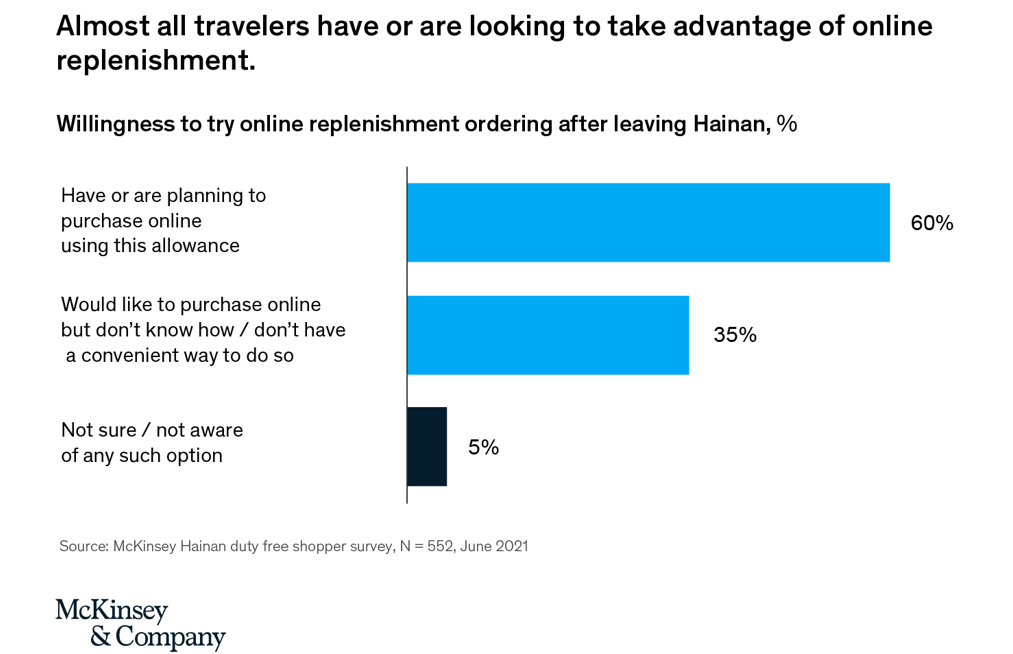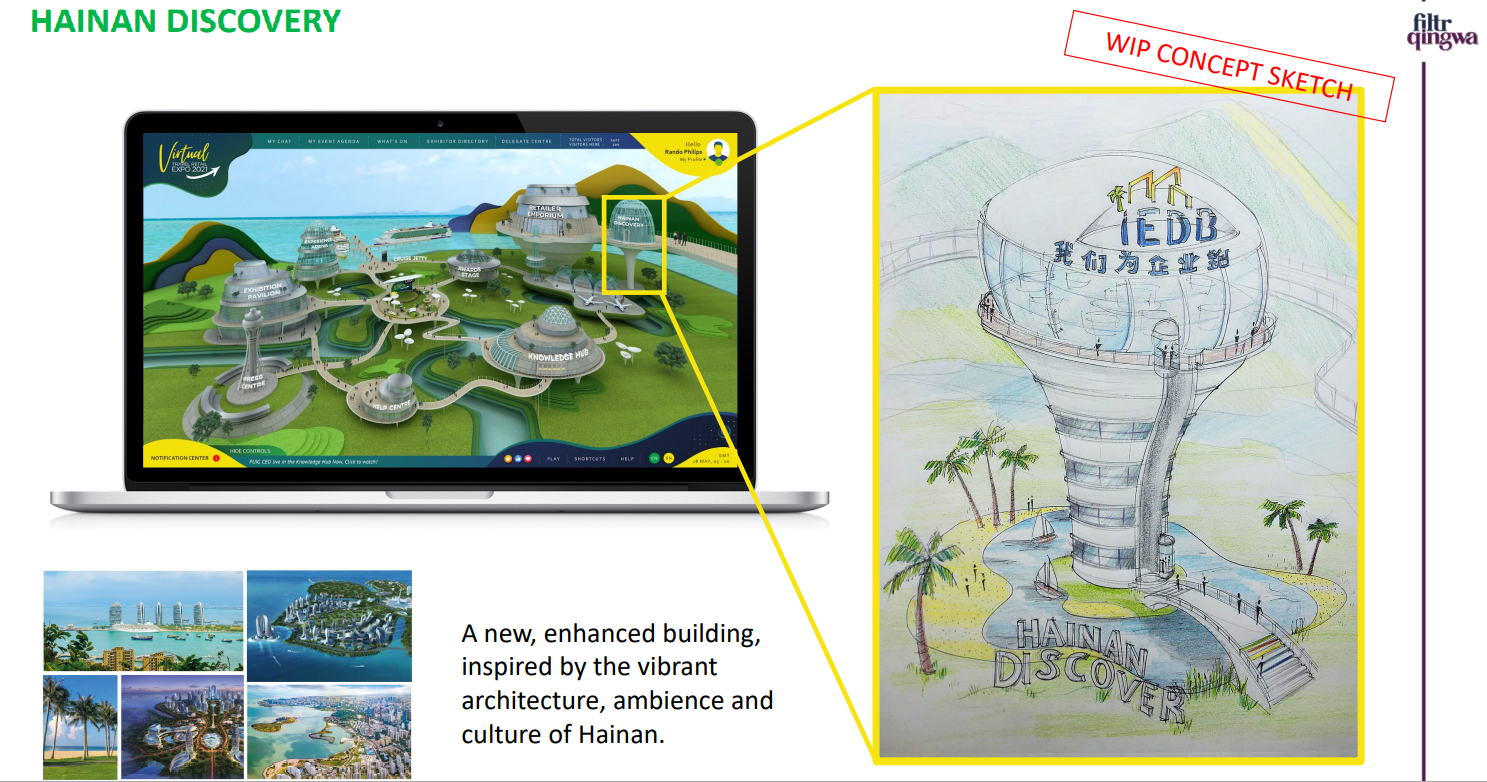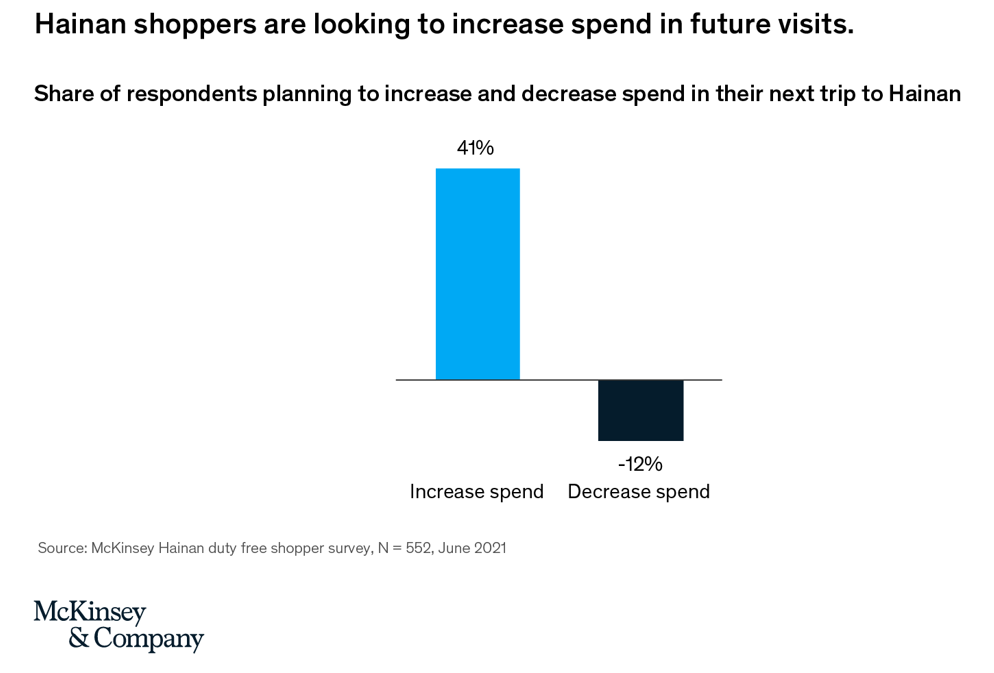 CHINA. Hainan’s booming offshore duty free retailing sector is set for strong growth even after Chinese outbound travel returns post the pandemic. That’s one of several key findings in an insightful new report from McKinsey & Company entitled Hainan’s $40 billion prize: The new battleground for global luxury.
CHINA. Hainan’s booming offshore duty free retailing sector is set for strong growth even after Chinese outbound travel returns post the pandemic. That’s one of several key findings in an insightful new report from McKinsey & Company entitled Hainan’s $40 billion prize: The new battleground for global luxury.
Based on a June survey of 550 Hainan duty free shoppers, the report, produced by Senior Partners Aimee Kim, Alex Sawaya (Hong Kong) and Associate Partner Michael Straub (Hong Kong), says that 62% of Hainan travellers this year are likely to return to the island after overseas travel is normalised.


Moreover, an impressive 95% of recent travellers said they have taken advantage of the new rules allowing for online post-travel duty free purchases or are looking to do so in future. Of those planning to return to Hainan, more than 40% seek to increase their spend next time, compared with only 12% looking to spend less.

Citing the Hainan Provincial Government’s 14th Five-Year Plan which estimates Hainan’s duty free market will grow tenfold between 2020 and 2025 to US$46.5 billion and become one of the world’s largest travel retail locations, McKinsey & Company said this “astonishing” growth will be driven by a cocktail of positive factors.
They include favourable regulations; increased investment from major stakeholders (traditional travel retailers and ecosystem players such as Alibaba and JD); and enhanced price competitiveness both vis-à-vis overseas duty free shopping destinations and over the Chinese local market.
Luxury brands should create a unified view of the Chinese customer across both Hainan and domestic businesses, via shared loyalty programmes, customer data platforms and a shared data analytics team enabled to retarget Hainan travellers after returning to their hometowns, and vice versa
Fashion forward
“While beauty has been leading the development of the market and accounted for roughly half of all Hainan duty free sales in 2020, there is a growing opportunity for other luxury categories as consumers look to diversify spend,” the report said. “For example, while only ~15 percent of beauty shoppers surveyed indicated they had purchased fashion during their most recent visit, almost one in three said they would like to do so on their next trip.”

Long term risks to luxury brands
The report also studies what it considers to be the risks to luxury brands under the model whereby the duty free retailer runs multi-brand and single-brand stores and commands strong control over inventory, pricing, and staff. This model has been successful at driving “immense” volumes through ultra-efficient sales aimed at price-sensitive, high-volume buyers.
However, it also entails significant risks for luxury brands in the long term, the report claims, including potential damage to brand equity; margin erosion; and lack of direct customer relationships.
McKinsey says that while some luxury brands have as a result eschewed the Hainan market until now, it is “imperative” that with the Hainan’s future status as an island-wide duty free zone,
The response of some luxury brands has been to actively limit their presence on the island or to refrain from opening a presence entirely. However, with Hainan growing fast to take an increasingly significant share of the Chinese luxury market, and slated to become a fully duty-free island province by 2025, it is imperative that luxury brands formulate a strategy to enter, operate, and scale in the market, the authors contend.
Key to a “winning play” will be to define a differentiated retail operating model with both strong incumbent duty free retailers and newcomers.
In a key observation, McKinsey & Co said that luxury brands should also create a unified view of the Chinese customer across both Hainan and domestic businesses, via shared loyalty programmes, customer data platforms and a shared data analytics team enabled to retarget Hainan travellers after returning to their hometowns, and vice versa.
“Making this happen will require brands to fundamentally rethink their domestic & travel retail organisations and collaboration model,” the authors said. That model will involve establishing a set of strategic partnerships with the aim of gaining critical access and capabilities in the market, in particular by:
- Exploring online collaborations with ecosystem players, for example home delivery and online replenishment offerings for unused duty free. The survey found that only 5% of shoppers surveyed took advantage of home delivery due to the hassle and long delivery times involved. Interestingly, 30% indicated they would like to replenish online but are unaware of a convenient way to do so.
- Managing relations with all key policymakers at the central, Hainan provincial, and municipal levels, accounting for different policy considerations and mandates.
- Gradually developing teams and capabilities, such as brand-owned supply chain strategy & oversight, real estate development, government relations, local merchandising & pricing, as well as a dedicated Hainan talent development unit.
- Maintaining agile Hainan brand-building operations: “Adopt a stage-gated investment model, in which new investments are unlocked once the prior stage has shown to produce results,” McKinsey recommends. This should give brands necessary flexibility in Hainan’s rapidly evolving market.
“Hainan’s authorities have made the most of limitations on international travel and inculcated a desire among Chinese luxury shoppers to support the island province’s development into a global duty free shopping hub,” the report concludes.
“The opportunity for luxury is evident, but in the current model trade-offs between driving volumes and protecting brand equity remain. The winners will be the brands that succeed in creating a new model that defines a luxury experience to attract customer interest in Hainan for years to come.”
Footnote: Hainan will figure prominently in the Virtual Travel Retail Expo this October (11-15) co-organised by The Moodie Davitt Report, FILTR.QINGWA and Hainan Provincial Bureau of International Economic Development (Hainan IEDB). Hainan IEDB is also Host of the Hainan Discovery zone pictured below.
The Hainan Discovery zone will showcase all aspects of Hainan’s Free Trade Port programme, with a focus on Hainan duty free retailers, hotels, service companies, brand experiences and the island’s wider tourism and leisure offer. It will feature a new level of digital engagement and will offer sponsorship, advertising and promotional opportunities for exhibitors and non-exhibitors alike.
For details please contact Irene Revilla at Irene@MoodieDavittReport.com
















